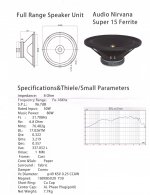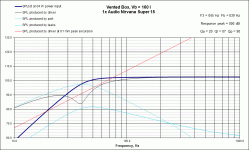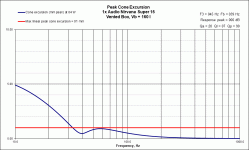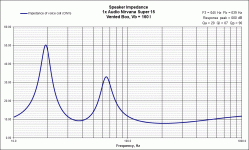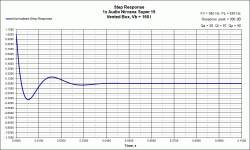Hello,
I've been lurking here for a while, and have been intrigued by the positive feedback for 15" Audio Nirvana drivers. It seems, though, that current production is essentially a new speaker (apparently made in a new factory since some time in 2020). I've attached datasheets for the old and new variants but for a quick glance:
spec old new
Qts .483 .322
Qms 8.221 3.219
Vas 618 L 337 L
BL 10.773 17.026
.. and those frequency response plots! It looks like the old version is about 92dB@30Hz, 96dB@40Hz where the old one is about 83dB@30Hz, 85db@40Hz; significantly less output at low frequencies. In fact, the new variant looks like it starts rolling off at about by 6dB/octave 100 Hz.
The vendor mentioned that this is the best sounding driver of all they manufacturer, that it represents an improvement over the old Super 15 ferrite, and that specs are really meanigless. Even if I were to accept that at face value, it does appear to me that this is a totally different driver, and any advice/recommendations/praise from prior to 2020 doesn't necessarily apply to the current offering.
So, would folks agree with my assessment that the current Super 15 is essentially a different product than the old Super 15? If so, does anybody have any experience with the new variant?
Thanks!
I've been lurking here for a while, and have been intrigued by the positive feedback for 15" Audio Nirvana drivers. It seems, though, that current production is essentially a new speaker (apparently made in a new factory since some time in 2020). I've attached datasheets for the old and new variants but for a quick glance:
spec old new
Qts .483 .322
Qms 8.221 3.219
Vas 618 L 337 L
BL 10.773 17.026
.. and those frequency response plots! It looks like the old version is about 92dB@30Hz, 96dB@40Hz where the old one is about 83dB@30Hz, 85db@40Hz; significantly less output at low frequencies. In fact, the new variant looks like it starts rolling off at about by 6dB/octave 100 Hz.
The vendor mentioned that this is the best sounding driver of all they manufacturer, that it represents an improvement over the old Super 15 ferrite, and that specs are really meanigless. Even if I were to accept that at face value, it does appear to me that this is a totally different driver, and any advice/recommendations/praise from prior to 2020 doesn't necessarily apply to the current offering.
So, would folks agree with my assessment that the current Super 15 is essentially a different product than the old Super 15? If so, does anybody have any experience with the new variant?
Thanks!
Attachments
Well, it certainly looks different, and the spec. is completely different. Although like many manufacturers, AN's published data has not always lined up especially well with 3rd party measurements. Below the mass-corner frequency (i.e. the region where T/S data is relevant) rolloff is dominated by Q -for a given Fs, the lower the total Q, the higher in frequency and shallower (initially) the rolloff will be.
Notwithstanding marketing hyperbole, since the original large AN units tended to have relatively high Q and Vas values, which demanded a very large enclosure by contemporary norms, the newer ones may allow for a better alignment in more modestly sized vented boxes -I haven't had chance to check. Assuming the different responses & T/S data are correct though, to say nothing of an apparently different basket, I do not see how any technical remarks that applied to the older units can be re-applied to the newer ones. Subjective comments are another story of course, since people can say what they like on that front.
Notwithstanding marketing hyperbole, since the original large AN units tended to have relatively high Q and Vas values, which demanded a very large enclosure by contemporary norms, the newer ones may allow for a better alignment in more modestly sized vented boxes -I haven't had chance to check. Assuming the different responses & T/S data are correct though, to say nothing of an apparently different basket, I do not see how any technical remarks that applied to the older units can be re-applied to the newer ones. Subjective comments are another story of course, since people can say what they like on that front.
Plugging in the new numbers into WinISD...now THIS might be interesting.
Gentle tweaking of the numbers gets you a very big box at 1600 liters, but the upside is getting a very extended lower response.
Given the giant enclosure we get -3.0 DB@18.64 hertz
An fb of 21 hertz...a large rectangular port of 0.5 meters by 0.3 meters by 333 mm long.
Would one dare building such a giant enclosure with those projected results? Yep, I would..now, where to put it? Note the X-max is at only one millimeter? I think it best to confirm those factory specs first...by saying, "specs are really meaningless" is an affront to the engineers who design these...mathematics is everything, our human perceptions are fraught with errors & not to be trusted.
------------------------------------------------------------------------Rick......
Gentle tweaking of the numbers gets you a very big box at 1600 liters, but the upside is getting a very extended lower response.
Given the giant enclosure we get -3.0 DB@18.64 hertz
An fb of 21 hertz...a large rectangular port of 0.5 meters by 0.3 meters by 333 mm long.
Would one dare building such a giant enclosure with those projected results? Yep, I would..now, where to put it? Note the X-max is at only one millimeter? I think it best to confirm those factory specs first...by saying, "specs are really meaningless" is an affront to the engineers who design these...mathematics is everything, our human perceptions are fraught with errors & not to be trusted.
------------------------------------------------------------------------Rick......
An externally hosted image should be here but it was not working when we last tested it.
New to the audio world, I have built Elekit amp and pre-amp, with the upgrades, and built speakers using the recently released AN15 Super 15 Ferrite as an 'ambience' set up, using a pair in each 265 litre birch plywood cabinet. 2 Subs take care of the lowest of frequencies and barely raise a sweat... Not sure if it's all up to audiophile calculated listening pleasures, but it's my first real attempt. Anyway, i think they sound fantastic. Very bright for at least the first 100 hours or so, but have mellowed sweetly since and continue to please. As I learn more, I'll possibly re calculate the 'boxes' since all i did was make what was suggested to me for them. They have a wide listening position, but if you are in the centre listening position they snap more into focus with the speakers disappearing, great wow factor for visitors who have not listened to 'good' set ups before. Overall, were 'cheapish' speakers to experiment with and thus far, not requiring upgrade. James.
Thanks, this is all helpful. I like hearing that the dispersion is still good with the new variant.
1600 liter performance notwithstanding, the newer Super 15 numbers looked quite decent in a large-but-not-overwhelming 160L bass reflex enclosure to my untrained eye. It was hard to reconcile this with the experience of folks who tried them in open baffles, or boffles, or huge boxes. This is what made me search through the internet archive to see if the specs in the first place.
Anyway, using the unibox spreadsheet, A 160L (5.7 cu ft) box tuned to 39 Hz appears to have (again, untrained eye) a nice flat response with
F3 = 45Hz
F6 = 37 Hz
F10 = 32 Hz
If I'm reading things right, it takes only 4W to approach its its modest 1mm Xmax in that 160L cabinet, resulting in an SPL of 102.5 dB at 1m. It seems to me the strongest advantage of the bass reflex box with this driver is to tame the Xmax in the 32Hz - 56Hz band. Looking at the closed box numbers, it would exceed Xmax below 56Hz, and be up to 1.6mm at 32 Hz.
I've attached some sheets from Unibox, reflecting a signal of 4W to this driver in the 160L enclosure
1600 liter performance notwithstanding, the newer Super 15 numbers looked quite decent in a large-but-not-overwhelming 160L bass reflex enclosure to my untrained eye. It was hard to reconcile this with the experience of folks who tried them in open baffles, or boffles, or huge boxes. This is what made me search through the internet archive to see if the specs in the first place.
Anyway, using the unibox spreadsheet, A 160L (5.7 cu ft) box tuned to 39 Hz appears to have (again, untrained eye) a nice flat response with
F3 = 45Hz
F6 = 37 Hz
F10 = 32 Hz
If I'm reading things right, it takes only 4W to approach its its modest 1mm Xmax in that 160L cabinet, resulting in an SPL of 102.5 dB at 1m. It seems to me the strongest advantage of the bass reflex box with this driver is to tame the Xmax in the 32Hz - 56Hz band. Looking at the closed box numbers, it would exceed Xmax below 56Hz, and be up to 1.6mm at 32 Hz.
I've attached some sheets from Unibox, reflecting a signal of 4W to this driver in the 160L enclosure
Attachments
I come to similar results when i model with the published specs, but the question is how far are they off (as AN is notorious for this) in real life. It's actually one of the better drivers on first sight, altough it will need a tweeter for above 10kHz and the response is not flat at all. It will need an attenuation filter (inductor and resistor) above 600Hz to flatten out the response also. And don't give it more than 6w or the bas response is cutted by the limited excursion of the cone.
Member
Joined 2009
Paid Member
Man, this is a crying shame, perhaps I should’ve bought a ‘spare’ driver when the old one’s were in production,
And the old one is what I have - nothing has been able to beat it
Whilst there’s a lot of nonsense marketed about these drivers I would agree that based on my experience with my AN 15” modelling has not been too relevant, i.e. you really do just need to put them in a big box, details are not critical, sound is superb.
Well, there’s something comforting about buying from a manufacturer that doesn’t outsource to China, and has a commitment to the long term with in house quality. This pushes me towards a two way, with a Lowther from 300Hz up. I bought a new Lowther last year, still NIB for the time being. Hope I haven’t jinxed them!
Perhaps Lii Audio makes for AN, they have similar products and plenty of folk like them.
If you haven’t yet tried a 15” full range - I strongly recommend it, it may be an end game for some applications.
And the old one is what I have - nothing has been able to beat it
Whilst there’s a lot of nonsense marketed about these drivers I would agree that based on my experience with my AN 15” modelling has not been too relevant, i.e. you really do just need to put them in a big box, details are not critical, sound is superb.
Well, there’s something comforting about buying from a manufacturer that doesn’t outsource to China, and has a commitment to the long term with in house quality. This pushes me towards a two way, with a Lowther from 300Hz up. I bought a new Lowther last year, still NIB for the time being. Hope I haven’t jinxed them!
Perhaps Lii Audio makes for AN, they have similar products and plenty of folk like them.
If you haven’t yet tried a 15” full range - I strongly recommend it, it may be an end game for some applications.
Last edited:
Yeah, at this point it's not worth the risk for me. A 160 L cabinet is a hard maximum as far as approval from the wife goes. I made the (mistake? fortunate decision?) of showing her pictures of the metronome the other day, and she loves it. Though it represents a somewhat opposite set of fullrange engineering decisions than the 15"AN drivers in huge cabinets, I've experienced neither approach and have to start somewhere.
you really do just need to put them in a big box, details are not critical, sound is superb.
If you haven’t yet tried a 15” full range - I strongly recommend it, it may be an end game for some applications.
Yeah, as Qts rises, the specs cover an ever decreasing BW [2*Fs/Qts] and no doubt why the pioneers designed drivers that when combined with a high output impedance amp + passive XOs the summed Qts' was generally in the 0.5-0.7 range.
Agreed, this one spoiled me in '65: rca lc-1a - Google Search
Attachments
Those RCAs are very interesting. I'd seen that unusual cone before but never fully investigated.
I've played around with some small semi decent full rangers but keep coming back to my crappy 8 inchers, I think one of these big guys from Li Audio might be in my future.
I've played around with some small semi decent full rangers but keep coming back to my crappy 8 inchers, I think one of these big guys from Li Audio might be in my future.
'Hard maximum' based on what max dims?
Width and depth combined, really. We created cardboard mockups based on the commonsenseaudio dimensions for 5.6 and 8.0 "stealth" cabinets, and went by look and feel at various places around the living room. Even though we have decent space, the larger cabinet didn't work aesthetically, and placement options were more limited. My wife vetoed the 8.0, so that's where the 'hard' limit came from
" My wife vetoed the 8.0, so that's where the hard limit came from."
Dude, you need to stand up for yourself...did you "veto" your wife when she bought those dozen pair of shoes the other day?...how about her giant closet?, & those things with the price-tag still on em?, never worn? I dare you to count just how many pairs of shoes she has, & compare the count to a count of YOUR footwear. Don't be P whipped...
-------------------------------------------------------------------------Rick.........
Dude, you need to stand up for yourself...did you "veto" your wife when she bought those dozen pair of shoes the other day?...how about her giant closet?, & those things with the price-tag still on em?, never worn? I dare you to count just how many pairs of shoes she has, & compare the count to a count of YOUR footwear. Don't be P whipped...
-------------------------------------------------------------------------Rick.........
- Home
- Loudspeakers
- Full Range
- Newest Audio Nirvana Super 15s
